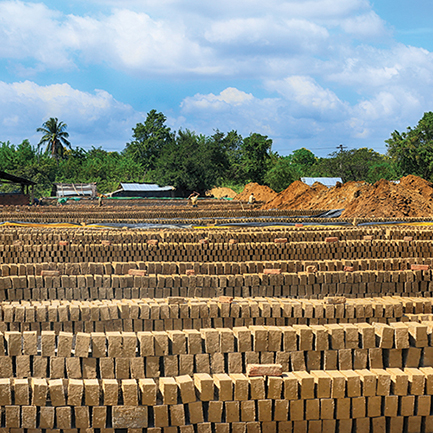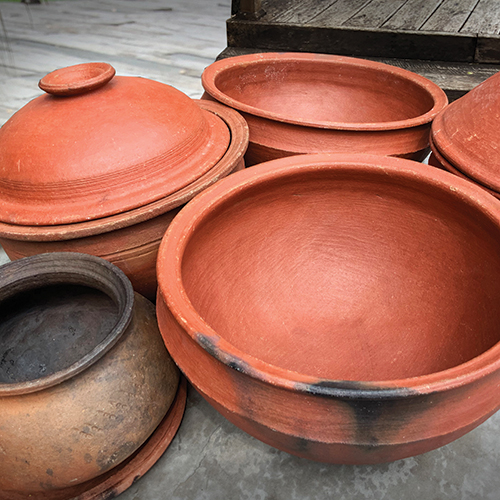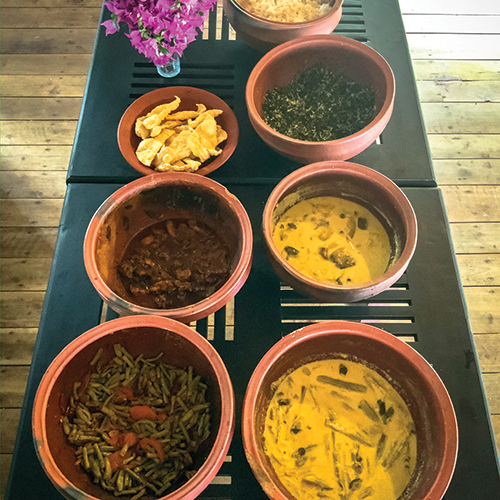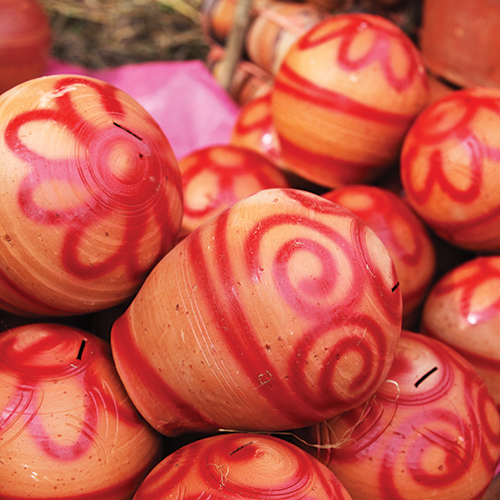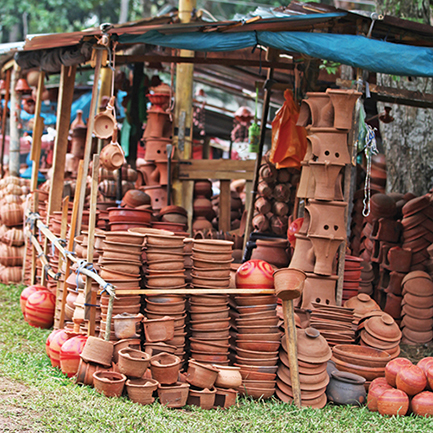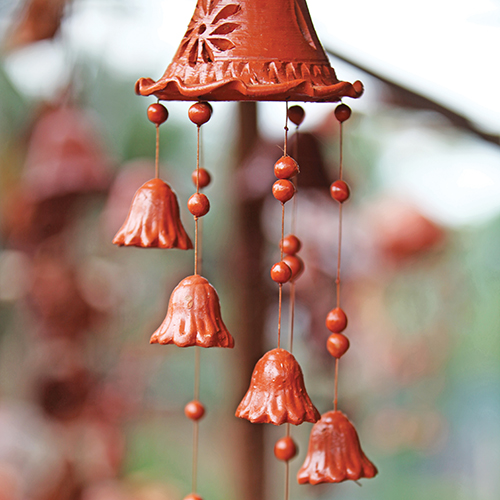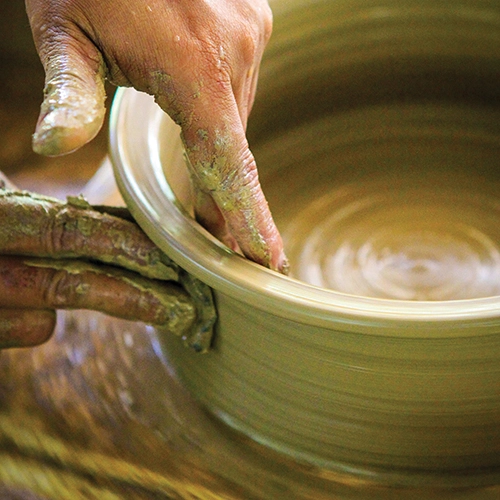
Words Jennifer Paldano Goonewardena.
The beauty of lithe hands giving shape to the clay at the wheel is fascinating. It is an act of artistry and craft, a demonstration of persistence and commitment to a history that has remained modest yet not obscure. Sri Lanka’s pottery industry has thrived for centuries in entire villages that practiced the trade unabated through changing times. Today, stirred consciences have given rise to an appreciation of ageless inheritances. And so in time, the potter’s wheel will rise with the revival of the industry through the Government’s vision ‘Saubagyaye Dekma’ that would restore the artisans’ status and promote their products as eco-friendly.
As for history, it is said that when Vijaya, a prince banished from India landed on the shores of Sri Lanka, his entourage had included potters. Bhikkuni Sangamitta, daughter of Emperor Asoka arrived in 288 BC with a branch of the Sacred Bo Tree from India, accompanied by artisans from 18 trades. And along came the potter. Archaeological findings though give credence to the country’s earthen- ware tradition dating back to the pre-historic period, such as the
megalithic tombs of Ibbankatuwa near Dambulla that had burial graves containing clay vessels (dating between 750-450 BC).
Other evidence from this period include the use of miniature clay pots to hold human remains interred in larger clay pots and boat-shaped clay tombs used to entomb smaller clay pots with remains. Interestingly, excavations of a house built of mud 3,000 years ago in Udaranchamadama, in Ratnapura had shards from a decorated clay pot, which experts believe was made on a potter’s wheel. Other items include clay beads used in jewelry. The broad spread of artisans in the country, from the villages in the Northwestern district of Kurunegala to the Western districts of Gampaha and Kalutara extending as far as the villages in the Eastern province provides validity to the historical body of evidence.
Utility and religion have historically driven the industry in the country. Earthenware items have governed the native kitchen and its activities, their utility have been re- markable for people raised in the tradition of consuming rice, with the ‘nembiliya’, a bowl used for centuries to strain washed grains into a basin known as the ‘koraha’, while the pitchers and cooking pots of different sizes, ewers and cups have performed remarkable functions where people gathered to interact over food.
Likewise, religious worship has been central to a meaningful existence for natives who used lamps, pots, and alms bowls and the vase shaped ‘kothalaya’ to perform rituals. While most utility and religious items are made using the ‘sakaporuwa’ or the potter’s wheel, other techniques, such as pinch pot, coil and slab, mold casting and sculpting also churn out various clay-based products in the vast repertoire. Sourced from mines in the wet, dry and intermediate zones, the Sri Lankan red clay is the main choice of potters owing to its prominent scarlet-infused shade and a standalone character of quality and strength. Kaolin also used in pottery, has to be strengthened with a combination of feldspar and silica. Likewise, ball clay is also reinforced with additional material to ensure strength.
Harvesting clay is a task driven by people outside the trade. Clay deposits are mined efficiently with machinery, although the best clay is harvested by diving into the water- logged mine. At the potter’s hands the raw clay goes through a rigorous refining process. The clay is stamped upon prior to being dried in the sun, and then immersed in water to allow it to break into particles, which is sieved to remove stones and other waste particles. The clay is again immersed in water and strained, then stored carefully for a few days for excess water to be absorbed into the ground or evaporate.
Earthenware items have governed the native kitchen and its activities, their utility have been remarkable…
A finished item transferred to a wooden plank is left to dry for a day and returns to the wheel to flake off any contusions with a hand-held tool. Engraving traditional designs on earthenware had been done for years with crushed and liquidized stones known as ‘guru’, which is applied to the dry item on the wheel, while designs were engraved meticulously with a tool. Today, the scarcity of this natural resource has led artisans to use iron oxide as a substitute. Every step of a product is detailed, and so is the final firing in the kiln, where accuracy of temperature seals the perfect product.
Free of harmful substances, using clay pots to cook and to serve is a healthy choice. Natives used them to preserve food, unspoiled and dry. Moreover, food cooked in clay vessels are generally considered tastier.
The commonest practice in Sri Lanka, followed even today is to dry clay utensils after every use on an apparatus known as the ‘walang messa’, which prevents the formation of fungi. The outdoor device is built near the kitchen. Even an urban household can practice this safe and easy method of keeping clay utensils clean by drying them in the sun after use.
A good clay pot has a smooth surface, with no visible pores or frag- ments in sight. Prior to purchase, the general practice is to test it by pouring water into the vessel to detect any leakage. Tapping the surface for sound, if hollow is considered too fragile.
Once a clay item is unusable or ruptured, the remains could be buried or crushed and strewn on the ground. Also, discarded clay pieces can be used to fill any crevices in the garden or gravel surfaces. From an aesthetic point of view, clay pieces can be used to create quirky mosaics on walls or the floor. Fragments can be handed over to outlets that collect them for recycling for future pottery production. This way, no one is saddled with the task of discarding remnants, because fusing them with our immediate environment is harmless and less scrappy.
Like most cottage industries that have merely survived through years of modernizing, pottery had seen better days, still survived because artisans had the creative energy of their ancestors.
Like most cottage industries that have merely survived through years of modernizing, pottery had seen better days, still survived because artisans had the creative energy of their ancestors. The State’s intervention to uplift the industry by providing access to raw material and machinery, and market opportunities will allow greater value additions and aesthetic focus. Sustainability and environmental consciousness have become movements for a cleaner and healthier world, and this new push hopes to make clay products a part of embracing the principles of sustainable practices in daily life. The winds of change is here; people are seeking authentic products devoid of toxic substances, and clay products are certainly the healthier choice.
Information provided by: Buddhika Sriyangani, Pottery Instructor
